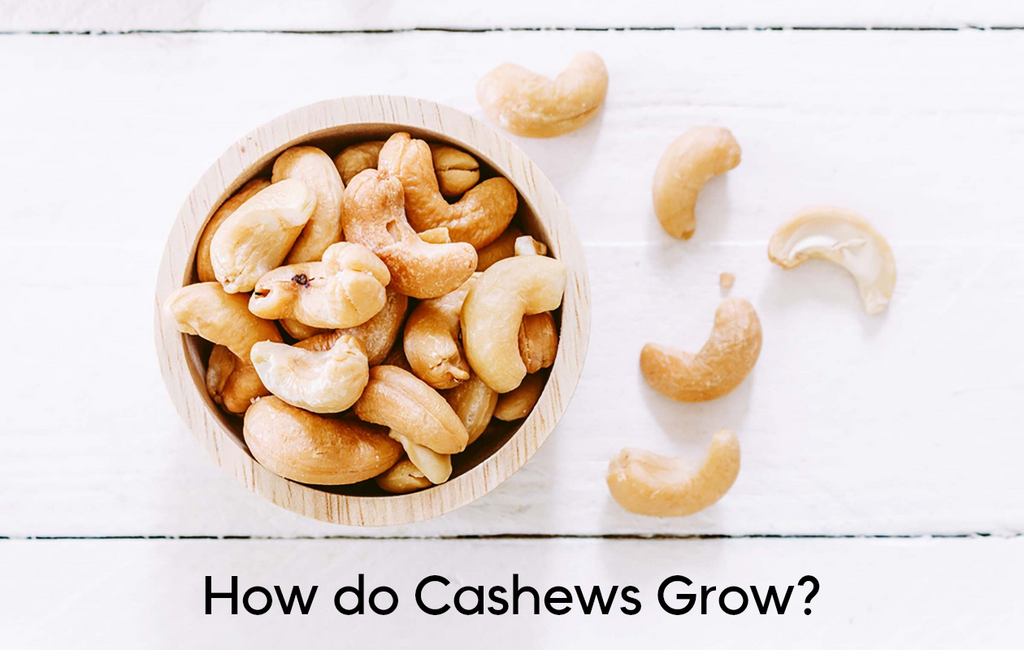# Type at least 1 character to search # Hit enter to search or ESC to close
How Do Cashews Grow?
Search
-
-
The Role of Food ...
Aug 07, 2025 -
Is Cashew Good Fo...
Jul 29, 2025
Archive
- September 2025
- July 2025
- June 2025
- May 2025

How Do Cashews Grow?
Have you ever wondered how cashews grow? These delectable nuts have an intriguing origin story. From their unique growth habits to the fascinating harvesting process, let's discover the captivating world of cashews and uncover the secrets behind these delicious tree nuts.
The Cashew Tree
The cashew tree – Anacardium occidentale – is a tropical evergreen tree native to northeastern Brazil. With its broad, lush leaves and an average height of 30-40 feet, it's a sight to behold. Thriving in warm climates, cashew trees are commonly found in regions like Brazil, India, Vietnam, and West Africa. Here is all you need to know about the cashew tree.
The Cashew Apple
Are you aware that cashews are, in fact, not nuts but seeds? The cashew apple is the fruit that emerges from the tree before the nut develops. Shaped like a bell pepper, the cashew apple is yellow or red, juicy, and pulpy. It possesses a sweet and slightly tangy taste, making it a unique treat in its own right. Although less common in international markets, the cashew apple is enjoyed in local cuisines, particularly in Brazil and some parts of Asia. Discover more about the fascinating cashew apple.
The Cashew Nut
The cashew nut, encased within the cashew apple, hides a treasure within. However, reaching the nut can be a complex process due to its peculiar structure. The cashew nut grows outside the fruit, attached to the bottom of the cashew apple. It emerges as a single nut per fruit, and between the nut and the apple is a protective layer known as the cashew shell.
The Harvesting Process
Harvesting cashews requires meticulous care and attention. Farmers carefully pluck the cashew apples from the trees, ensuring they are fully ripe. Next comes the delicate task of extracting the cashew nuts. However, handling the cashew shell can be challenging as it contains a toxic resin called urushiol, which can cause skin irritations. Therefore, proper precautions are taken to prevent any contact with the resin during the process.
Drying and Shelling
After harvesting, cashews undergo a drying process to reduce moisture content and extend their shelf life. Once dried, they are ready for shelling. Specialized machines or skilled artisans carefully crack open the cashew shells, revealing the precious cashew nut hidden within. It's remarkable how something so small and delicate can be so well-protected by nature. It's worth knowing the difference between cashew nuts and cashew kernels.
Market Availability and Culinary Uses
Once shelled, cashew nuts make their way to markets worldwide, where they are available in various forms. Raw, roasted, salted, or even transformed into creamy cashew butter, these nuts lend their rich, buttery flavor and creamy texture to a plethora of dishes. Cashews are widely used in both savory and sweet recipes, adding a delightful crunch and enhancing the overall taste and texture.
ConclusionThe journey of cashews, from their tropical origins to our plates, is nothing short of fascinating. From the vibrant cashew apple to the protective cashew shell, nature presents us with a remarkable gift.
Understanding how cashews grow reminds us of the intricacies of our food and the immense effort it takes to bring these culinary delights to our tables. So, the next time you enjoy the creamy richness of cashews in a dish, take a moment to appreciate the wonder of nature's nutty creation.
© 2022 WWCashews. All Rights Reserved | 1-888-404-0472 | info@wwcashews.com





Leave a comment